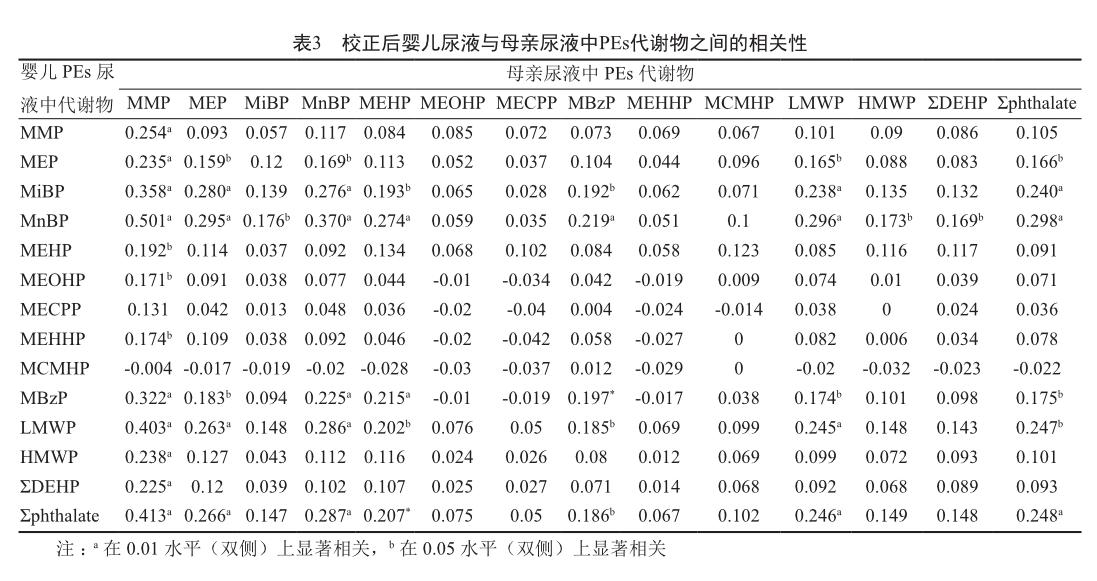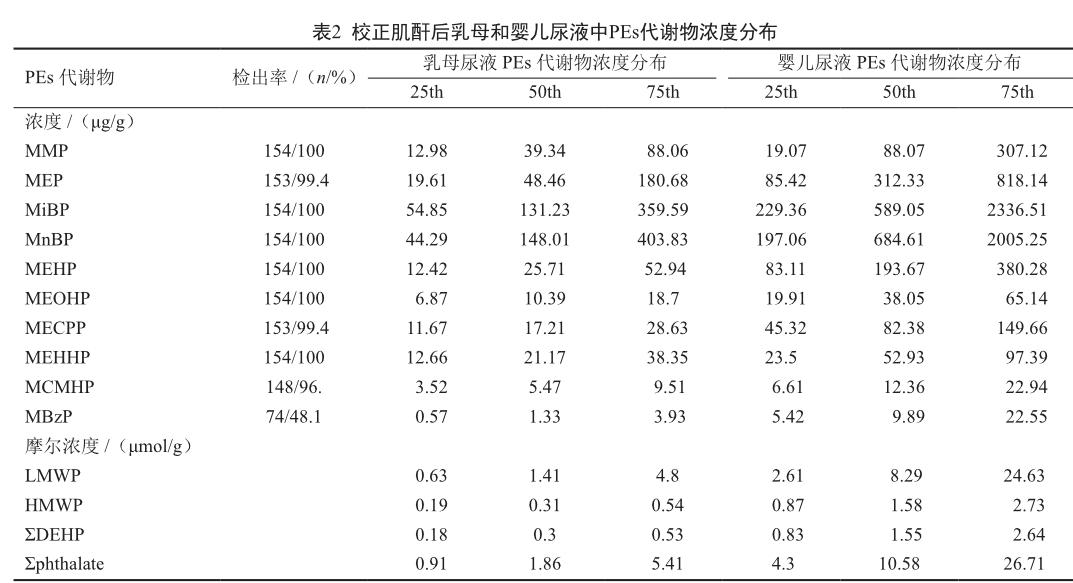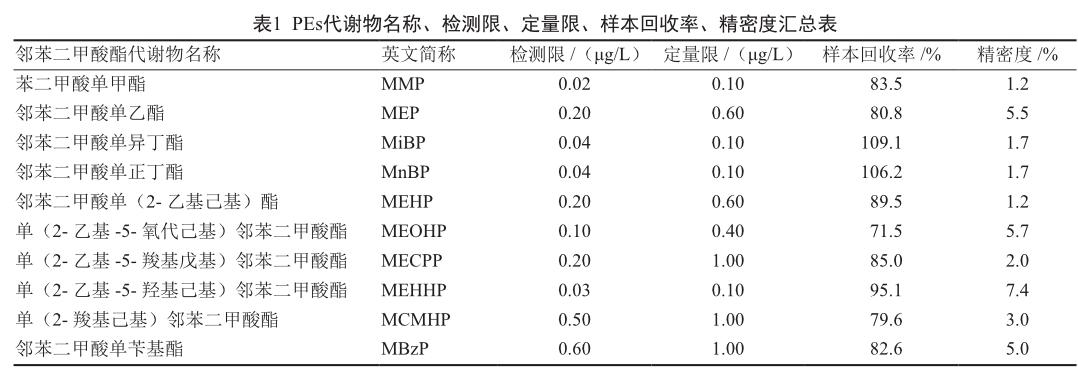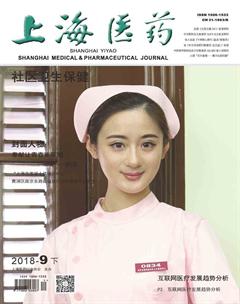乳母与哺乳期婴儿邻苯二甲酸酯类物质暴露水平的相关性
邱竞逸 吴昊 张梅如 王蕾 陈波



摘要 目的:利用乳母与婴儿尿中邻苯二甲酸酯代谢物研究邻苯二甲酸酯类物质(phthalates,PEs)的暴露水平,探讨乳母与婴儿邻苯二甲酸暴露水平之间的相关性。方法:采用横断面调查方法对154对婴儿和及其乳母进行问卷调查并采集随机尿样;采用高效液相色谱-串联质谱法检测婴儿及其乳母尿中10种PEs浓度;分析尿肌酐校正后的PEs相关性。结果:乳母与婴儿尿液中PEs浓度相关性多集中在乳母尿液中的MMP、MEP、MiBP、MnBP、MEHP和MBzP与婴儿尿液中的MEP、MiBP、MnBP、MBzP、LMWP、HMWP和Σphthalate之间(P<0.05),相关系数r在0.176~0.501之间。结论:上海市三个区(县)乳母和婴儿的PEs暴露水平较高,且婴儿暴露水平高于乳母,婴儿PEs的暴露与其乳母存在显著的相关性,这表明有必要控制母亲对PEs的接触。
关键词 邻苯二甲酸酯类物质;哺乳期暴露;乳母;婴儿;相关性
中图分类号:R174+.4 文献标志码:A 文章编号:1006-1533(2018)18-0058-05
The correlation between the exposure levels of phthalates in lactating mothers and nursing infants
QIU Jingyi1, WU Hao1, ZHANG Meiru2, WANG Lei3, CHEN Bo2(1. Community Development Section of Baiyu Community Health Service Center of Changfeng Community of Putuo District, Shanghai 200063, China; 2. Department of Nutrition and Food Hygiene of Public Health School of Fudan University, Shanghai 200032, China; 3. Community Development Section of Baoshan Community Health Service Center of Jingan District, Shanghai 200071, China)
ABSTRACT Objective: To use phthalate metabolites in the urine of lactating mothers and infants to study the exposure levels of phthalates(PEs) to explore the correlation of the level exposure of phthalates between them. Methods: A questionnaire was conducted in 154 infants and their lactating mothers and random urine samples were collected by a cross-sectional survey; high performance liquid chromatography-tandem mass spectrometry(HPLC) was used to detect 10 PEs concentrations in the urine of infants and their lactating mothers to analyze the correlation of PEs after creatinine correction. Results: The correlation between PEs concentrations in the urine of lactating mothers and infants was mainly concentrated in MMP, MEP, MiBP, MnBP and MEHP and MBzP in the urine of mothers and MEP, MiBP, MnBP, MBzP, LMWP, HMWP and Σphthalate in the urine of infants(P<0.05), and the correlation coefficient r was between 0.176~0.501. Conclusion: The PEs exposure level of lactating mothers and infants in three districts(counties) of Shanghai is relatively high, and the exposure level of the infants is higher than that of the lactating mothers, and there is a significant correlation between the exposure of infant PEs and their lactating mothers, which indicates that it is necessary to control the mothers contact with PEs.
KEY WORDS phthalates; lactational exposure; lactating mother; infant; correlation
邻苯二甲酸酯类物质(phthalates,PEs)種类繁多,被广泛用作为聚氯乙烯聚合物、非聚氯乙烯聚合物、非聚合物的增塑剂,以及其他消费产品的助剂,这些助剂常用于制造塑料制品、装修材料和医疗器械等[1]。研究表明,PEs会在使用过程中通过直接释放、迁移、淋溶和磨损不断向环境中释放,主要经口、呼吸道、皮肤和静脉途径进入人体。其中食品摄入是PEs暴露的最主要途径[2]。婴幼儿还通过舔吮塑料玩具及安抚奶嘴摄入PEs。PEs进入人体后代谢迅速,其代谢物大部分在24 h内通过尿液排出体外,尿中代谢物的浓度可反映24 h内相应PEs的暴露水平[3]。尿液中PEs的代谢物,尤其是氧化代谢产物,不容易受外源性污染的干扰。目前,人群流行病学研究主要采用尿液作为生物监测样本,进行PEs暴露评估和风险评估[4]。本研究旨在了解乳母与婴儿尿中PEs的暴露水平,探讨乳母和婴儿PEs暴露水平之间相关性。
1 对象与方法
1.1 对象
通过儿童预防保健系统,筛选上海市三个区正处于母乳喂养或母乳混合喂养阶段的月龄在0~8个月的婴儿及其乳母154对。乳母年龄中位数为29岁,最小为18岁,最大为41岁,婴儿为0~9月龄,月龄中位数为5月龄。采用横断面调查的研究方法进行问卷调查,采集乳母和婴儿尿液各10 ml进行PEs的含量检测。
1.2 研究方法
采用高效液相色谱-串联质谱法(High performance liquid chromatography tandem mass spectrometrym,HPLCMS/MS)[5]共检测尿中10种PEs的代谢产物,其英文简写、方法的检测限、定量限、样本回收率、精密度见表1。由于人的随机尿样容易被稀释,因此本文检测的PEs的代谢产物的浓度均经肌酐矫正。所有未检出数据用1/2检测限(limit of detection,LOD)替代。LMWP为MMP、MEP、MiBP和MnBP总和;HMWP为MBzP、MEHP、MEHHP、MECPP、MEOHP和MCMHP总和;ΣDEHP为MEHP、MEHHP、MECPP、MEOHP和MCMHP总和;Σphthalate为PEs代谢物总和。
1.3 統计学方法
运用IBM SPSS 21.0对进行统计分析,经正态性检验,校正肌酐后乳母尿液和婴儿中PEs代谢物浓度呈偏态分布,因而使用频数、四分位数进行描述性分析,采用Spearman相关性分析。
2 结果
2.1 乳母和婴儿尿液中PEs代谢物的检出情况
校正肌酐后乳母尿液中PEs代谢物浓度分布中位数排名前五位的均依次是MiBP、MnBP、MEP、MMP和MEHP。校正肌酐后婴儿尿液中PEs代谢物浓度分布中位数前五位均依次为MiBP、MnBP、MEP、MEHP、MECPP,而且经肌酐矫正后的婴儿尿中PEs代谢物的浓度高于乳母的浓度水平。见表2。
2.2 乳母尿液中PEs代谢物之间的相关性
除MBzP外的9种PEs代谢物以及4种PEs代谢物总和之间存在正相关性(P<0.01)。MBzP与MEP、MEHP、MEOHP、MECPP、MEHHP、MCMHP、HMWP、ΣDEHP和Σphthalate的相关系数在0.173~0.798范围。ΣDEHP一级代谢物MEHP与4种二级代谢物MEOHP、MECPP、MEHHP和MCMHP相互之间均有明显的正相关性(P<0.05),一级代谢物MEHP与4种二级代谢物的相关系数在0.458~0.685范围,二级代谢产物MEOHP、MECPP、MEHHP和MCMHP之间的相关系数r在0.460~0.957范围。
2.3 婴儿尿液中PEs代谢物之间的相关性分析
除DEHP的二级代谢物MEOHP、MECPP、MEHHP和MCMHP与一级代谢物MEP、MiBP、MnBP、MEHP之间无相关性;MBzP与DEHP二级MEOHP、MECPP、MEHHP和MCMHP无相关性;MMP与HMWP和ΣDEHP无相关性。其他DEHP一级代谢物之间和4种邻苯二甲酸酯代谢物总和之间存在正相关性(P<0.01)。MBzP与MMP、MEP、MiBP、MnBP、MEHP、HMWP、ΣDEHP和Σphthalate相关系数在0.185~0.784范围。二级代谢产物MEOHP、MECPP、MEHHP和MCMHP之间的相关系数在0.711~0.987范围。
2.4 乳母与婴儿尿液中PEs代谢物的相关性分析
乳母与婴儿尿液中邻苯二甲酸酯代谢物浓度存在正相关性的多集中在乳母尿液代谢物指标MMP、MEP、MiBP、MnBP、MEHP和MBzP与婴儿尿液中代谢物指标MEP、MiBP、MnBP、MBzP、LMWP、HMWP和Σphthalate(P<0.05),相关系数在0.176~0.501范围,见表3。
3 讨论
本研究中,MiBP和MnBP合称为MBP,乳母尿液中MBP的暴露水平虽低于韩国和台湾地区,但远高于发达国家美国和一些欧洲国家,处于较高水平[6-9]。MEP和MMP含量高于台湾、日本等人群研究结果[10, 11],又远低于美国、荷兰、墨西哥等欧美国家[12]。既往文献认为PEs的主要来源为食品摄入、个人用品和室内空气,人群可通过呼吸和饮食和饮水、直接接触而吸收此类物质。MBzP污染较严重的个人用品除食品外,还包括女性常用的香水、指甲油等个人护理用品,PEs常被添加于香水等个人护肤品中[13]。由于越来越多的女性使用香水、指甲油、香体乳等护理用品,接触多了使吸收摄入也随之增加,这可能是MBzP和MEP检出率高于既往的国内文献结果而低于国外文献结果的原因之一。也可能与不同国家化妆品的使用习惯不同有关。
本研究中婴儿尿液中代谢物浓度高于国内人群相关调查和美国及一些欧洲国家的结果[13],但文献中的儿童年龄范围在10岁以内。本文中受检婴儿(0~8月龄内)的尿中PEs的代谢产物浓度较高,考虑可能由于婴儿肾脏发育和功能与成年人有差异,测得的肌酐值偏低,导致校正肌酐后婴儿尿液中PEs代谢物浓度偏高。
在本研究中,肌酐校正后乳母尿液中除MBzP外的9种PEs代谢物以及4种PEs代谢物总和之间均存在正相关性。PEs可分为短链和长链结构,进入人体后代谢迅速,经历水解和共轭两个代谢过程。短链的先被水解为初级代谢产物(邻苯二甲酸单酯),而长链的除被水解为相应的邻苯二甲酸单酯外,可发生羟基化和氧化反应,再生成为氧化单酯为二级代谢物。肌酐校正后婴儿PEs代谢物浓度正相关性主要集中在初级代谢物内部之间和二级代谢物内部之间,初级代谢物与二级代谢物之间无相关性,这与肌酐校正后的乳母尿液中浓度存在很大的差异,主要原因为婴儿的肾脏发育和功能相对不够完全。肌酐校正后的母乳尿液中浓度与婴儿尿液中浓度的正相关性主要集中在初级代谢物之间,可能是婴儿比乳母存在更多的暴露机会,主要为混合喂养方式,安抚奶嘴的使用,塑料玩具的舔吮等。
本研究由于样本量还不够大,仅有154对乳母婴儿配对样本,统计分析容易造成偏倚;而且本次采集的样本为随机尿样,若采用24 h尿样,会使结果更加准确,相关性分析更具说服力;由于婴儿的混合喂养以及更多暴露途径,虽然母乳可能是PEs暴露重要来源,但是单纯的母乳喂养和较少暴露途径的婴儿在研究此类相关性上可以做出更好地解释。
本研究顯示,上海市三个区154对乳母和婴儿PEs的暴露水平较高,婴儿PEs暴露水平高于其乳母。由于婴儿在调查期间仍存在母乳喂养,乳母与婴儿PEs的暴露水平在初级代谢物和二级代谢物上都存在正相关性。提示乳母乳汁中PEs代谢物通过母乳喂养方式使婴儿暴露PEs。说明婴儿尿液中PEs代谢物含量不仅取决于婴儿本身塑料制品使用,还包括乳汁摄入。提示乳母应控制自身塑料制品的使用、塑料包装食品的摄入和化妆品的使用,才能同时降低婴儿PEs的暴露。本研究提示,降低乳母PEs的暴露对降低婴儿PEs的暴露水平有着积极的作用。虽然本研究仍存在一些不足和局限,但是也补充了我国乳母和婴儿PEs暴露水平和相关性的资料空白。
参考文献
[1] Blount BC, Silva MJ, Caudill SP, et al. Levels of seven urinary phthalate metabolites in a human reference population[J]. Environ Health Perspect, 2000, 108(10): 979-982.
[2] Guo Y, Alomirah H, Cho HS, et al. Occurrence of phthalate metabotites in human urine from several Asian countries[J]. Environ Sci Technol, 2011, 45(7): 3138-3144.
[3] Wittassek M, Koch HM, Angerer J, et al. Assessing exposure to phthalates-the human biomonitoring approach [J]. Mol Nutr Food Res, 2011, 55(1): 7-31.
[4] Esteban M, Castano A. Non-invasive matrices in human biomonitoring: A review[J]. Environ Int, 2009, 35: 438-449.
[5] 张晗. 上海社区居民邻苯二甲酸酯累积暴露风险评估[D].上海: 复旦大学公共卫生学院, 2016.
[6] Buck Louis GM, Sundaram R. Urinary bisphenol A, phthalates, and couple fecundity: the Longitudinal Investigation of Fertility and the Environment (LIFE) Study[J]. Fertility and sterility, 2014, 101(5): 1359-1366.
[7] Colacino JA, Harris TR. Dietary intake is associated with phthalate body burden in a nationally representative sample[J]. Environmental health perspectives, 2010, 118(7): 998-1003.
[8] Hogberg J, Hanberg A. Phthalate diesters and their metabolites in human breast milk, blood or serum, and urine as biomarkers of exposure in vulnerable populations[J]. Environmental health perspectives, 2008, 116(3): 334-9.
[9] Ji K, Lim Kho Y. Influence of a five-day vegetarian diet on
urinary levels of antibiotics and phthalate metabolites: a pilot study with “Temple Stay” participants[J]. Environmental research, 2010, 110(4): 375-382.
[10] Huang PC, Kuo PL. Association between prenatal exposure to phthalates and the health of newborns[J]. Environment international, 2009, 35(1): 14-20.
[11] Suzuki Y, Niwa M. Prenatal exposure to phthalate esters and PAHs and birth outcomes[J]. Environment international, 2010, 36(7): 699-704.
[12] Guo Y, Wu Q. Phthalate metabolites in urine from China, and implications for human exposures[J]. Environ Int, 2011, 37(5): 893-898.
[13] Schettler T. Human exposure to phthalates via consumer products[J]. International journal of andrology, 2006, 29(1): 134-139, 81-85.

